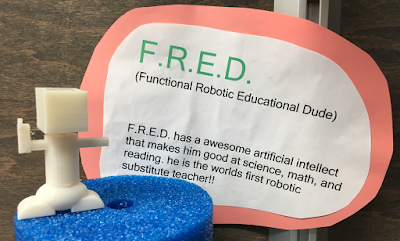 |
| Fourth grade student created substitute teacher robot of the future. |
After learning about 3D printers at the annual Minnesota TIES Technology Conference in December 2014, principal Dave Parker met with Media Specialist Colleen Small and put together a plan to begin researching and secure funding for a 3D printer at their school. Colleen wanted an enclosed printer that would keep fingers out during the printing process, so she began a trial period with a Stratys Mojo printer. The vendor was very supportive in helping to get things going. Colleen began learning how to use it and get students involved, too. The Groveland PTA ended up purchasing the printer.
 |
| Groveland Elementary's Stratys 3D printer |
 Colleen explained that although each kid had an account, not all designs were printable. She says it was a great spatial learning task and experience for the students, as many didn't realize their drawings and objects were not on the same work plane. Some students robots might have looked OK from the front, but when viewed from all angles the models had disconnected parts. Students who created models that were all connected were able to print their designs and take them home. Some students' projects are pictured.
Colleen explained that although each kid had an account, not all designs were printable. She says it was a great spatial learning task and experience for the students, as many didn't realize their drawings and objects were not on the same work plane. Some students robots might have looked OK from the front, but when viewed from all angles the models had disconnected parts. Students who created models that were all connected were able to print their designs and take them home. Some students' projects are pictured.
 |
| Hand printed from Project Enable design. |
 |
| Senior student designed phone case. |
It is fun to see 3D printers in use from our youngest to oldest students. I'm anxious to see more of what they create in the future. Perhaps soon they will start to include integrated and printed circuits like I saw at CES. Perhaps they'll be printing food for our cafeteria, too!



No comments:
Post a Comment